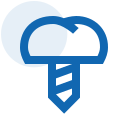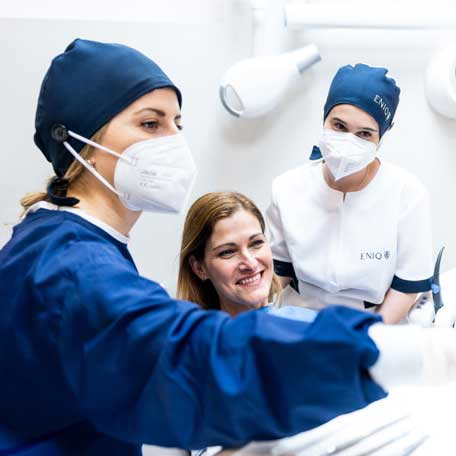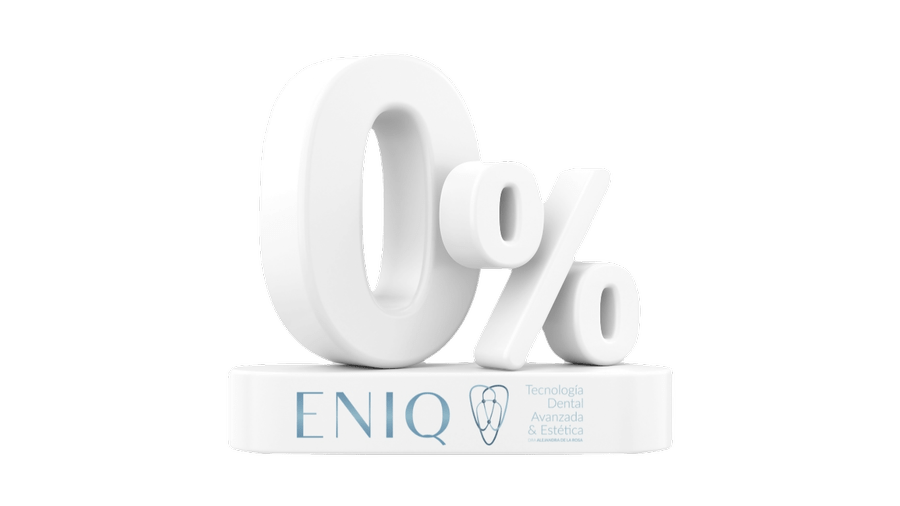

Maxillary Sinus Lift
ENIQ Dental Clinic, specialists in maxillary sinus lift in Madrid.
What is a Maxillary Sinus Lift?
The maxillary sinuses are two cavities located on either side of the nose, below the eyes. They are the area where air from the nasal passages enters and is warmed, preparing it for the lungs. This influences ventilation and also has resonance functions.
The cavity of the maxillary sinus is lined internally with mucosa.
In a sinus lift, this mucosa is elevated to create space for bone placement, thus providing sufficient bone height for the subsequent placement of a dental implant.
Sometimes, due to the loss of teeth, the bone in the upper jaw loses height, making it impossible to rehabilitate the lost teeth in a fixed manner.
This is why the sinus lift technique is used prior to implant placement.
It is important to note that the placement of fixed prostheses on dental implants requires a process that can involve several stages and take several months, depending on the patient's individual situation. A careful evaluation and planning by a dentist specialized in implantology is required to determine the patient's suitability and ensure the success of the treatment.
How is a Sinus Lift Performed?
The sinus lift is performed through a surgical technique that involves elevating the membrane covering the sinus and placing synthetic bone in the gained space, followed by a synthetic collagen membrane if needed.
There are two surgical techniques for maxillary sinus lift:
- Open (lateral) sinus lift technique
- Closed (atraumatic) sinus lift technique
This is used when a large amount of bone is needed (less than 5 mm of bone) and involves lifting the mucosa, making a small hole in the bone of the maxillary sinus, and then carefully detaching the mucosa to place the synthetic bone, followed by suturing and waiting for the bone to consolidate.
This less traumatic technique, which we use and develop at ENIQ with dynamic guided navigation, allows the patient to have bone without any trauma. A small hole is made in the sinus and bone is injected through it. After about 6 months, this synthetic bone (bone inducer) can be replaced by the patient's own bone. In some cases, this is done on the same day as the implant placement to save the patient multiple surgical interventions. The accuracy of dynamic guided navigation used at ENIQ ensures a very precise, comfortable, and minimally invasive treatment, covered with the patient's own mucosa, avoiding extensive surgeries.
Duration
How Many Appointments Are Necessary for a Maxillary Sinus Lift?
Depending on the technique used, if the traumatic lateral technique is employed, a minimum of 6 months is needed for bone stabilization. With the atraumatic technique, which requires at least 5 mm of bone, the implant could even be placed at the same time.

What Are the Advantages of Dental Implants?
-
It is a relatively simple intervention when performed by a trained professional.
-
The implant can be placed at the same time, provided conditions allow it.
-
This avoids the need for more aggressive surgical techniques such as zygomatic implants.
- We avoid zygomatic implants which is a more aggressive surgical technique.
+90%
What is the Success Rate of Maxillary Sinus Lifts?
The direct or lateral sinus lift technique is a predictable implant therapy with high success rates after 3 years, exceeding 90%.
What is the price of sinus lift surgery?
In those patients who have lost bone, it is necessary to perform a bone regeneration to be able to place the dental implants. There are various techniques to obtain bone and we will choose one or the other depending on the size of the area to be regenerated.
In the simplest cases, synthetic bone is used and the cost usually ranges around 350 euros.
For its part, when the area to be regenerated is larger, we will have to use additional materials, such as membranes. This makes the procedure more expensive, so the cost can rise to 800-1,500 euros.

At ENIQ, we can propose to split your payments from 150€ to 3000€ without any documentation, and from there our financing options can be very flexible.
Maxillary Sinus Lift
High-end implant
*subject to specialist evaluation
High-end Straumann group implant, healing screws, prosthetic abutment, trans-epithelial, high-end 3D technology zirconia crown, radiodiagnostic CT scans, and computer-guided navigation application for precise surgery, without sutures, without large incisions, and above all painless, costs 1800€.
-
All included
-
Interest-free financing
Frequently Asked Questions
Do you have more questions about the maxillary sinus lift procedure?
At ENIQ, with our dynamic guided navigation technology Navident, the trauma with this type of technique is going to be much less.
The postoperative of the sinus lift is much less painful since the open wound will be much smaller.
Conscious sedation: is a technique that reduces anxiety and nerves. This makes the patient relaxed during the entire surgery.
For patients who have lost bone, bone regeneration is necessary to place dental implants. There are various techniques to achieve bone, and we choose one depending on the size of the area to regenerate.
In simpler cases, synthetic bone is used and the cost is usually around 350 euros.
On the other hand, when the area to regenerate is larger, we need to use additional materials, such as membranes. This increases the cost of the procedure, so it can go up to 800-1,500 euros.
Really, if there are economic possibilities, a sinus lift is better as it somehow regenerates and prevents bone aging, translated into the loss of maxillary height that is noticeable at a certain age.
If there is no economic possibility, one can resort to prostheses (fixed and removable) that will return function and aesthetics to the patient.
It is important that the professional has full knowledge of the surgical principles and anatomical structures involved in the intervention, their embryological origin, as well as the physiology of the maxillary sinus, before proceeding with the procedure.
Also, they must know the different techniques to achieve that 90% success rate that characterizes this type of technique today.
Generally, the side effects of oral surgery are minimal, so not all of these postoperative instructions are given.
Care of your mouth is very important for proper healing. The following instructions will maximize your healing and improve the long-term outcome of your dental implant or implants.
It is very important that you avoid smoking for at least 5 days. In fact, avoiding smoking during healing will significantly increase the likelihood of success in integrating the bone graft and implant. Smoking increases your bleeding; the nicotine and tar in tobacco hinder healing. We cannot guarantee implants to our patients who use tobacco (whether in pipe, cigar, cigarette, or chewed).
If you had a sinus lift, DO NOT blow your nose, or hold your sneeze for 7–10 days. You can use physiological saline nasal spray. There may be nasal bleeding during the first days of the sinus lift.
If only sutures were placed, do not chew until the sutures are removed 10 to 15 days later.
Partial dentures, temporary teeth, or full dentures can be used as soon as you feel comfortable but only if the prosthesis does not touch the graft site.
Do not engage in vigorous physical activity for a week after your surgery unless we have given you other instructions. Physical activity increases your blood pressure, which will cause an increase in your swelling, pain, and bleeding. After a week, you can gradually increase your activity, such as jogging or playing tennis.
Swelling is normal after surgery and can cause discomfort. You should apply an ice pack to the surgical area for periods of 20 minutes every 20 minutes, for the first 24 hours, to minimize swelling. Swelling usually reaches its critical point 48 hours after surgery. When resting, adopt a semi-vertical position with your head elevated above your heart.
You may go home with gauze packs in your mouth, but you will need to change them once you get home, every 15–30 minutes until the bleeding decreases.
Rest the day after surgery. Take the prescribed pain reliever before the numbness begins to wear off, making sure you have eaten first. If you start to have hives or a rash due to any of the medications, stop them and notify the surgeon. Remember that narcotics for pain can affect your judgment and reflexes. Take your prescribed antibiotics and continue with them until they are finished.
If you feel nauseous, drink small portions of carbonated drinks, every hour for 3 or 4 hours. This will usually eliminate your nausea. Soft foods like crackers, tea, clear broths, jelly, applesauce, or toasted bread without butter can also help with nausea. While you have nausea, avoid all dairy products.
If you have been prescribed an antibacterial mouthwash, rinse gently twice a day for 7–10 days, starting 24 hours after your surgery. Warm salt water rinses are also recommended, starting the night after surgery. Dissolve 1 teaspoon of salt with 8 ounces of hot water. Brush your teeth twice a day, doing so gently initially around the surgical site.
The soft diet is high in protein including foods like scrambled eggs. Increase your fluid intake to at least four glasses per day.
